
Balancing Management Styles for a Remote Workforce


The pandemic has indeed impelled organizations to rethink the way they approach traditional business operations. The market realigned businesses to adapt to the changing environment and optimize their costs. For the past couple of months, nearly every organization implemented work for home as a mandate. This shift in operations had both highs and lows in terms of productivity. Almost a year into the pandemic, the impacts are yet to be fully understood. The productivity realized from the remote workers, month on month, shaped the policies and led to investments in different tools that aided collaboration between teams.
Technology companies have been leading the charge towards remote working as many have adopted permanent work from home options for their employees. While identifying cost avenues for optimization, office space allocation and commuting costs are places where redundant operational cash flow can be invested to other areas for scaling.
The availability and speed of internet connections across geographies have aided the transformation of office spaces for better utilization of the budget. Considering the current economy, office spaces are becoming expensive and inefficient. The Annual Survey by JLL Enterprises in 2020 reveals that organizations spend close to $10,000 on global office real estate cost per employee per year on an average. As offices have adopted social distancing policies, the need for more space per employee would result in even higher costs during these pandemic operations. To optimize their budgets, companies have reduced their allocation spaces and introduced regional contractual sub-offices to reduce the commute expenses of their employees in the big cities.
With this, the notion of a 9-5 job is slowly being depleted and people have been paid based on their function rather than the time they spend at work. The flexibility of working hours while linking their performance to their delivery has seen momentum in terms of productivity per resource. An interesting fact that arose out of this pandemic economy is that the number of remote workers in a country is proportional to the country’s GDP. A work from home survey undertaken by The Economist in 2020 finds that only 11% of work from home jobs can be done in Cambodia, 37% in America, and 45% in Switzerland.
The fact of the matter is that a privileged minority has been enjoying work from home for the past couple of months. While a vast majority of the semi-urban and rural population don’t have the infrastructure to support their functional roles. For better optimization and resource utilization, India would need to invest heavily in these resources to catch up on the deficit GDP from the past couple of quarters.
Long-term work from home options challenges the foundational fabric of our industrial operations. It can alter the shape and purpose of cities, change workplace gender distribution and equality. Above all, it can change how we perceive time, especially while estimating delivery.
Many employees prefer to work from home as they can devote extra time to their family. While this option has been found to have a detrimental impact on organizational culture, creativity, and networking. Making decisions based on skewed information would have an adverse effect on the culture, productivity, and attrition.
To gather sufficient input for decisions, PWC conducted a remote work survey in 2020 called “When everyone can work from home, what’s the office for“. Here are some insights from the report
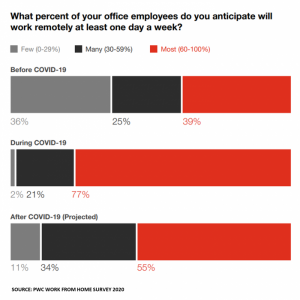
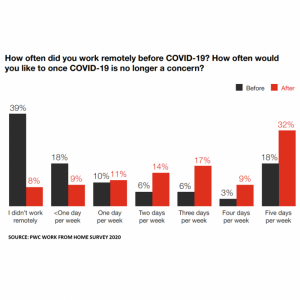
Many businesses have aligned themselves to accommodate both on-premise and remote working model. Organizations need to figure out how to better collaborate and network with employees in ways to elevate the organization culture.
As offices are slowly transitioning to a hybrid model, organizations have decentralized how they operate. They have shifted from working in a common centralized office to contractual office spaces as per employee role and function, to better allocate their operational budget. The survey found that 72% of the workers would like to work remotely at least 2 days a week. This showcases the need for a hybrid workspace in the long run.
During the transition, keeping a check on the efficiency of remote workers was prime. The absence of these checks would jeopardize the delivery, resulting in a severe impact on customer satisfaction and retention.
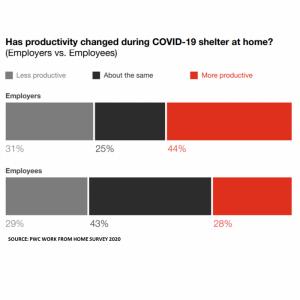
This number however, could be far less if the scale of the survey was higher. This in turn signifies that productivity is not uniform and requires course corrective action to maintain the delivery. An initial approach from an employee’s standpoint would result in higher results. The measures to help remote workers be more productive were found to be as follows.
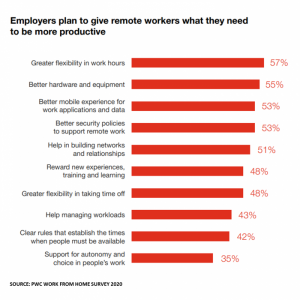
Many employees point out that greater flexibility of working hours and better equipment would help increase work productivity.
Most of the productivity hindrances can be solved by effective employee management. How a particular manager supervises their team members has a direct correlation towards their productivity and satisfaction to the project delivery.
Theory X and Theory Y were introduced by Douglas McGregor in his book, “The Human Side of Enterprise”. He talks about two styles of management in his research – Authoritarian (Theory X) and Participative (Theory Y). The theory heavily believes that Employee Beliefs directly influence their behavior in the organization. The approach that is taken by the organization will have a significant impact on the ability to manage team members.
For theory X, McGregor speculates that “Without active intervention by management, people would be passive, even resistant to organizational needs. They must therefore be persuaded, rewarded, punished, controlled and their activities must be directed”
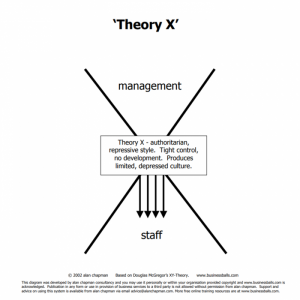
Work under this style of management tends to be repetitive and motivation is done based on a carrot and stick approach. Performance Appraisals and remuneration are directly correlated to tangible results and are often used to control staff and keep tabs on them. Organizations with several tiers of managers and supervisors tend to use this style. Here authority is rarely delegated, and control remains firmly centralized.
Even though this style of management may seem outdated, big organizations find it unavoidable to adopt due to the sheer number of employees on the payroll and tight delivery deadlines.
When it comes to Theory Y, McGregor firmly believes that objectives should be arranged so that individuals can achieve their own goals and happily accomplish the organization’s goal at the same time.
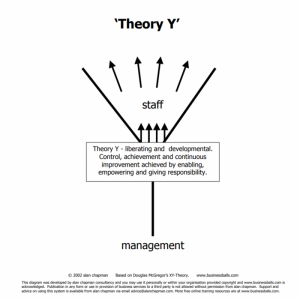
Organizations that follow this style of management would have an optimistic and positive approach to people and problems. Here the team management is decentralized and participative.
Working under such organizational styles bestow greater responsibilities on employees and managers encourage them to develop skills and suggest areas of improvement. Appraisals in Theory Y organizations encourage open communication rather than to exercise control. This style of management has been popular these days as it results in employees wanting to have a meaningful career and looking forward to things beyond money.
Even though McGregor suggests that Theory Y is better than Theory X. There are instances where managers would need to balance the styles depending upon how the team function even post the implementation of certain management strategies. This is very important from a remote working context as the time for intervention would be too late before it impacts the delivery. Even though Theory Y comprises creativity and discussion in its DNA, it has its limitations in terms of consistency and uniformity. An environment with varying rules and practices could be detrimental to the quality and operational standards of an organization. Hence maintaining a balance is important.
When we look at a typical cycle of Theory X, we can find that the foundational beliefs result in controlling practices, appearing in employee resistance which in turn delivers poor results. The results again cause the entire cycle to repeat, making the work monotonous and pointless.
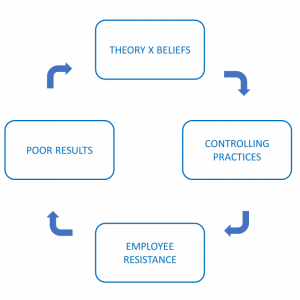
Upon the identification of resources that require course correction and supervision, understanding the root cause and subsequently adjusting your management style to solve the problem would be more beneficial in the long run. Theory X must only be used in dire circumstances requiring a course correction. The balance where we need to maintain is on how far we can establish control to not result in resistance which in turn wouldn’t impact the end goal.
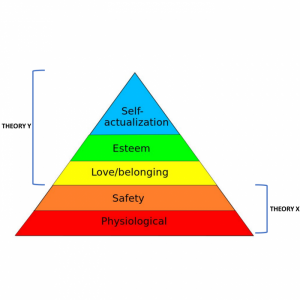
Theory X and Theory Y can be directly correlated to Maslow’s hierarchy of Needs. The reason why Theory Y is superior to Theory X is that it focuses on the higher needs of the employee than their foundational needs. The theory Y managers gravitate towards making a connection with their team members on a personal level by creating a healthier atmosphere in the workplace. Theory Y brings in a pseudo-democratic environment, where employees can design, construct and publish their work in accordance with their personal and organizational goals.
When it comes to Theory X and Theory Y, striking a balance will not be perfect. The American Psychologist Bruce J Avolio, in his paper titled “Promoting more integrative strategies for leadership theory-building,” speculates, “Managers who choose the Theory Y approach have a hands-off style of management. An organization with this style of management encourages participation and values an individual’s thoughts and goals. However, because there is no optimal way for a manager to choose between adopting either Theory X or Theory Y, it is likely that a manager will need to adopt both approaches depending on the evolving circumstances and levels of internal and external locus of control throughout the workplace”.
As circumstances keep changing by the day, organizations need to adapt to the rate at which the market is changing to envision new working models that take human interactions into account as well. The crises of 2020 made organizations build up their workforce capabilities that are critical for growth. Organizations must relook at their workforce by reskilling them in different areas of digital expertise as well as emotional, cognitive, and adaptive skills to push forward in our changing world.

“ Ashish Joseph is a Lead Consultant at GAVS working for a healthcare client in the Product Management space. His areas of expertise lie in branding and outbound product management.“
Please complete the form details and a customer success representative will reach out to you shortly to schedule the demo. Thanks for your interest in ZIF!